Abdu Saif
Climate-Resilient UAVs: Enhancing Energy-Efficient B5G Communication in Harsh Environments
Sep 17, 2023Abstract:This paper explores the crucial role of Unmanned Aerial Vehicles (UAVs) in advancing Beyond Fifth Generation (B5G) communication networks, especially in adverse weather conditions like rain, fog, and snow. The study investigates the synergy between climate-resilient UAVs and energy-efficient B5G communication. Key findings include the impact of weather elements on UAV coverage and communication dynamics. The research demonstrates significant enhancements in energy efficiency, reduced interference, increased data transmission rates, and optimal channel gain under various weather conditions. Overall, this paper emphasizes the potential of climate-resilient UAVs to improve energy-efficient B5G communication and highlights technology's role in mitigating climate change's impact on communication systems, promoting sustainability and resilience.
Flexible Beamforming in B5G for Improving Tethered UAV Coverage over Smart Environments
Jul 14, 2023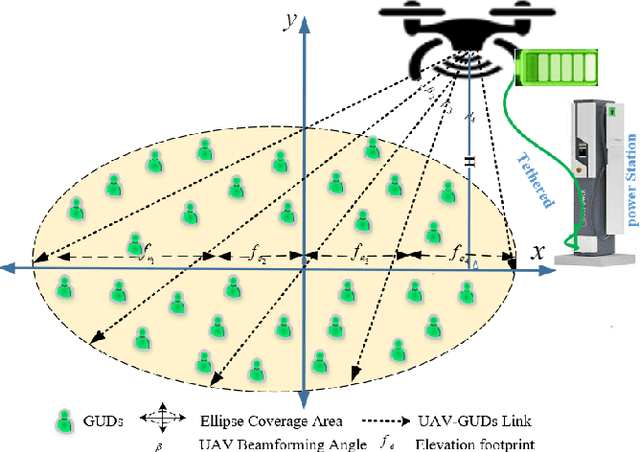
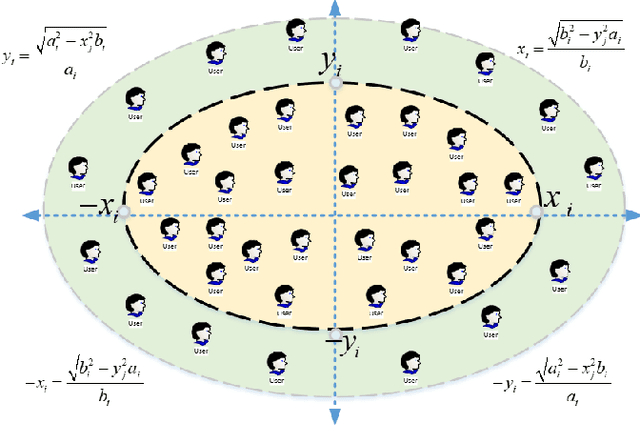
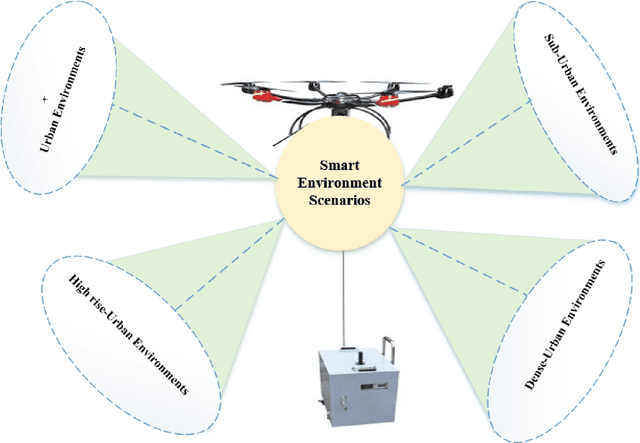
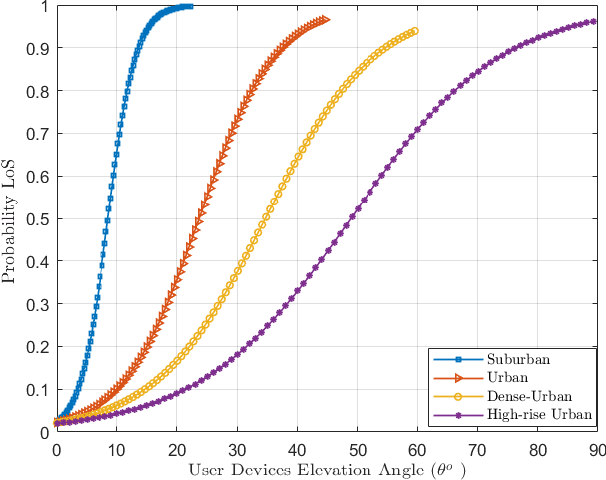
Abstract:Unmanned Aerial Vehicles (UAVs) are being used for wireless communications in smart environments. However, the need for mobility, scalability of data transmission over wide areas, and the required coverage area make UAV beamforming essential for better coverage and user experience. To this end, we propose a flexible beamforming approach to improve tethered UAV coverage quality and maximize the number of users experiencing the minimum required rate in any target environment. Our solution demonstrates a significant achievement in flexible beamforming in smart environments, including urban, suburban, dense, and high-rise urban. Furthermore, the beamforming gain is mainly concentrated in the target to improve the coverage area based on various scenarios. Simulation results show that the proposed approach can achieve a significantly received flexible power beam that focuses the transmitted signal towards the receiver and improves received power by reducing signal power spread. In the case of no beamforming, signal power spreads out as distance increases, reducing the signal strength. Furthermore, our proposed solution is suitable for improving UAV coverage and reliability in smart and harsh environments.
An Efficient Game Theory-Based Power Control Algorithm for D2D Communication in 5G Networks
Mar 08, 2023Abstract:Device-to-Device (D2D) communication is one of the enabling technologies for 5G networks that support proximity-based service (ProSe) for wireless network communications. This paper proposes a power control algorithm based on the Nash equilibrium and game theory to eliminate the interference between the cellular user device and D2D links. This leads to reliable connectivity with minimal power consumption in wireless communication. The power control in D2D is modeled as a non-cooperative game. Each device is allowed to independently select and transmit its power to maximize (or minimize) user utility. The aim is to guide user devices to converge with the Nash equilibrium by establishing connectivity with network resources. The proposed algorithm with pricing factors is used for power consumption and reduces overall interference of D2Ds communication. The proposed algorithm is evaluated in terms of the energy efficiency of the average power consumption, the number of D2D communication, and the number of iterations. Besides, the algorithm has a relatively fast convergence with the Nash Equilibrium rate. It guarantees that the user devices can achieve their required Quality of Service (QoS) by adjusting the residual cost coefficient and residual energy factor. Simulation results show that the power control shows a significant reduction in power consumption that has been achieved by approximately 20% compared with algorithms in [11].
D2D Multi-hop Energy Efficiency Toward EMS in B5G
Sep 27, 2022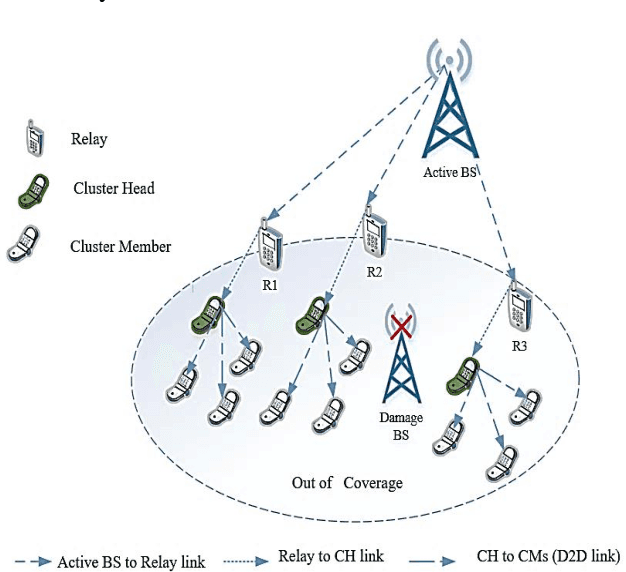
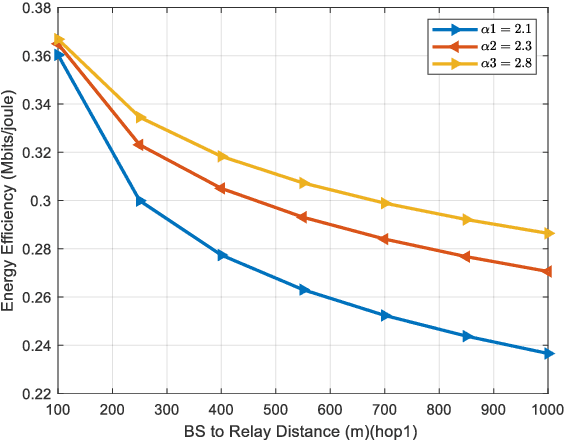
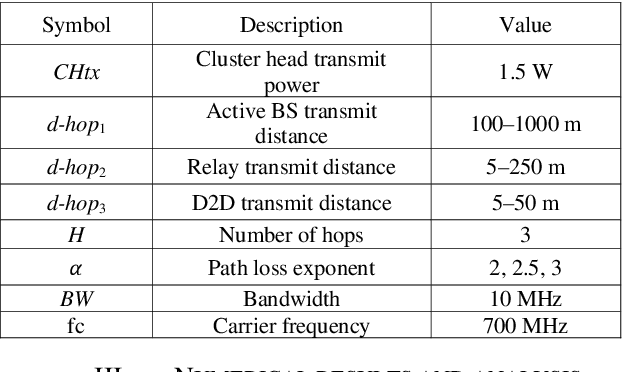
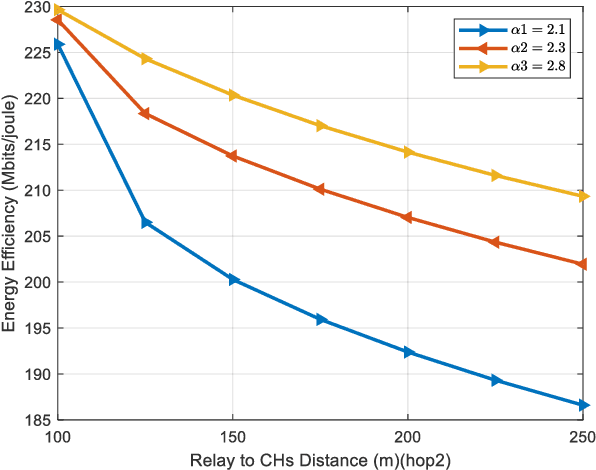
Abstract:Beyond fifth generation (B5G), communication has attracted much attention from academia, industry, and mobile network operators due to network densification, ultra-low latency communication, and enhanced energy and spectrum efficiency. However, a post-disaster emergency management system (EMS), which increasingly relies heavily on wireless communication infrastructure, is falling far behind in innovation and funding. Because the B5G concept represents a telecommunications industry revolution, EMS provisioning is intended to be dispersed, autonomous, and robust to network weaknesses caused by human and natural calamities. When the network is congested, partially functioning, or entirely isolated, we provide multi-device-to-device (D2D) communication to extend the communication coverage area with improved energy efficiency. Furthermore, we examine D2D multi-hop energy efficiency performance in the proposed network. The results demonstrate that the improved D2D multi-hop energy efficiency can improve the EMS effectively and efficiently in extending the coverage area and enhancing energy efficiency. Moreover, the proposed approach has been proven to increase energy efficiency, which acts as a suitable network design to recover from natural disasters and potentially save many lives
An Efficient 3D Indoor Positioning System Based on Visible Light Communication
Sep 15, 2022



Abstract:In this communication revolution era, visible light communication (VLC) is the optimum efficacious answer to the increased request for high-speed data transmission with reduced cost, besides the illumination. This technology is considered the best promising candidate for indoor positioning due to its ability to attain higher positioning accuracy than other technologies, alongside its distinct advantages. However, the existing techniques that had been applied in an indoor positioning system (IPS) based on VLC focused on the aspect of accuracy but neglected the aspects of cost and complexity. This paper proposes a new technique for positioning, namely complementary and supplementary angles based on received signal strength (CSA-RSS). The positioning error performance of the system is examined based on the single light-emitting diode (LED) and different positions of the photodiode (PD). The results demonstrate the improved accuracy and prove the effectiveness of the newly proposed technique where the average error is 3.2 cm in 80% of the examined positions and the maximum average positioning error is 4.2 cm. Moreover, the proposed approach has been proven to increase system efficiency which acts as a suitable VLC design for indoor positioning performance, avoiding weak signals
A Compact Size 5G Hairpin Bandpass Filter with Multilayer Coupled Line
Oct 07, 2021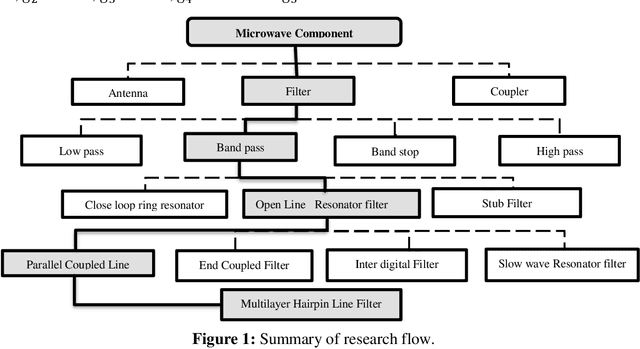

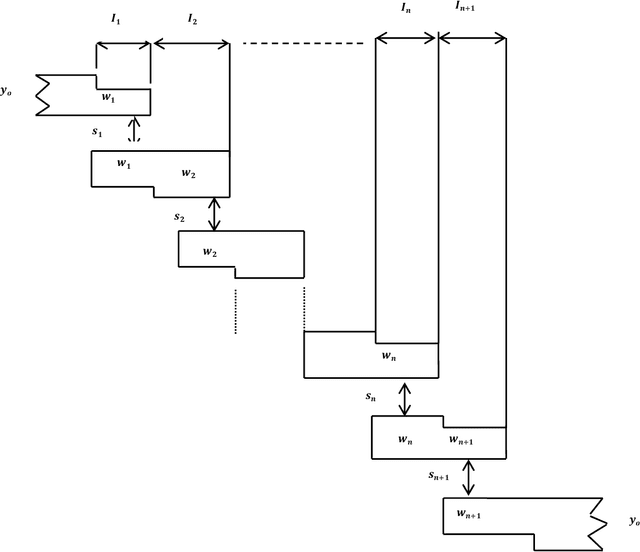
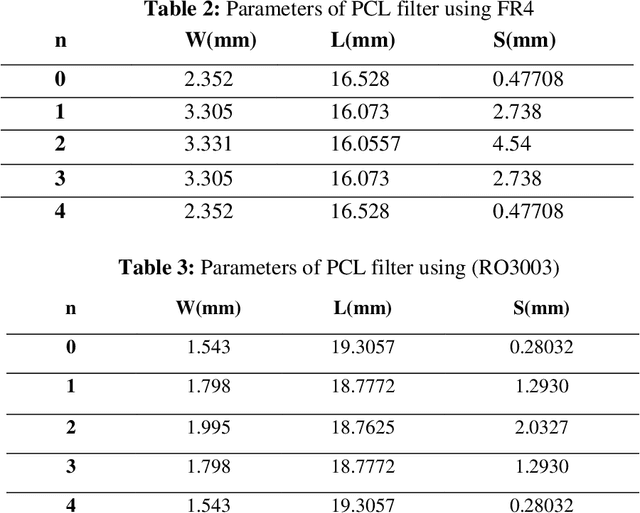
Abstract:The multilayer structure is a promising technique used to minimize the size of planar microstrip filters. In the flexible design and incorporation of other microwave components, multilayer band-pass filter results in better and enhanced dimensions. This paper introduces a microstrip fifth-generation (5G) low-frequency band of 2.52-2.65 GHz using a parallel-coupled line (PCL) Bandpass filter and multilayer (ML) hairpin bandpass filter. The targeted four-pole resonator has a center frequency of 2.58 GHz with a bandwidth of 130 MHz. The filters are designed with a 0.1 dB passband ripple with a Chebyshev response. The hairpin-line offers compact filter design structures. Theoretically, they can be obtained by bending half-wavelength resonator resonators with parallel couplings into a "U" shape. The proposed configuration of the parallel-coupled line resonator is used to design the ML band-pass filter. The FR4 substrate with a dielectric constant ({\epsilon}r) of 4.3 and 1.6 mm thickness was used. A comparative analysis between the simulated insertion loss and the reflection coefficient of substrates RO3003 and FR4 was performed to validate the efficiency of the proposed filter design. Simulation of PCL filter is accomplished using computer simulation technology (CST) and an advanced design system (ADS) software. The PCL Bandpass filter was experimentally validated and a total tally between simulation results and measured results were achieved demonstrating a well-measured reflection coefficient. The simulated results obtained by the hairpin ML bandpass filter show that the circuit performs well in terms of Scattering(S) parameters and the filter size is significantly reduced.
Energy-Efficient Tethered UAV Deployment in B5G for Smart Environments and Disaster Recovery
Jul 17, 2021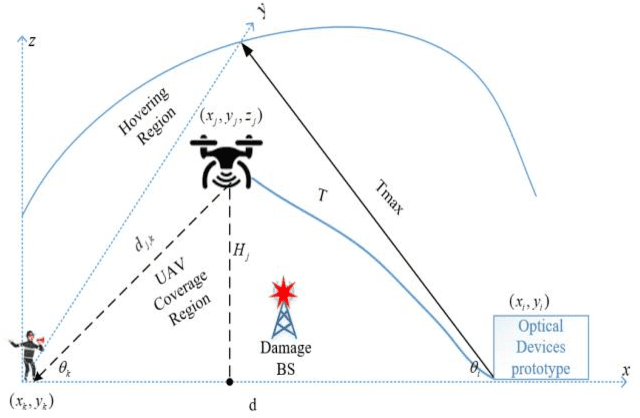

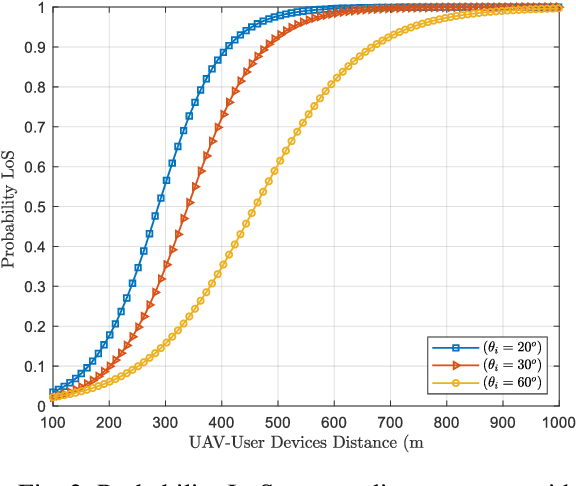
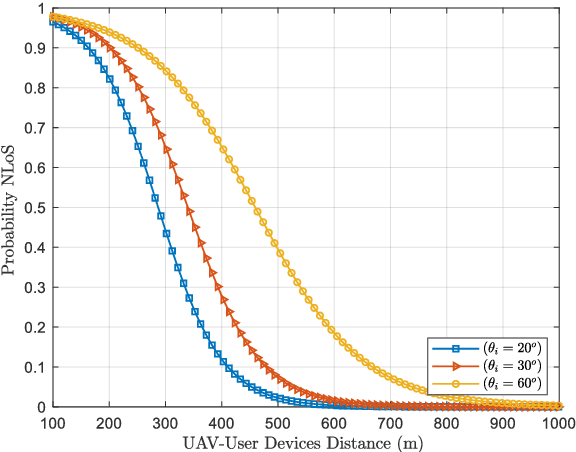
Abstract:Due to Unmanned aerial vehicles (UAVs) limitations in processing power and battery lifetime. The tethered UAV (TUAV) offers an attractive approach to answer these shortcomings. Since a tethered connected to UAV is one potential energy solution to provide a stable power supply that connects to the ground would achieve impressive performances in smart environments and disaster recovery. The proposed solution is intended to provide stable energy and increase the coverage area of TUAV for smart environments and disaster recovery. This paper proposed that the tethered connected to UAV will provide the continuous supply and exchange the data with ground terminals. Besides the adjustable tether length, elevation angels act to increase the hovering region, leading to the scalability of coverage in many applications. Moreover, the power consumption and transmission the distance while achieving a trade-off between the hovering and coverage probabilities. The simulation results demonstrate efficient performance in terms of line-of-sight probability, path loss, and coverage probability for scalability coverage smart environments and disaster recovery scenarios. Furthermore, maximum coverage probability is achieved versus increased tethered length because of the gain and fly over a region of maximum tethered.
Pilot Contamination Elimination for Channel Estimation with Complete Knowledge of Large-Scale Fading in Downlink Massive MIMO Systems
Jun 25, 2021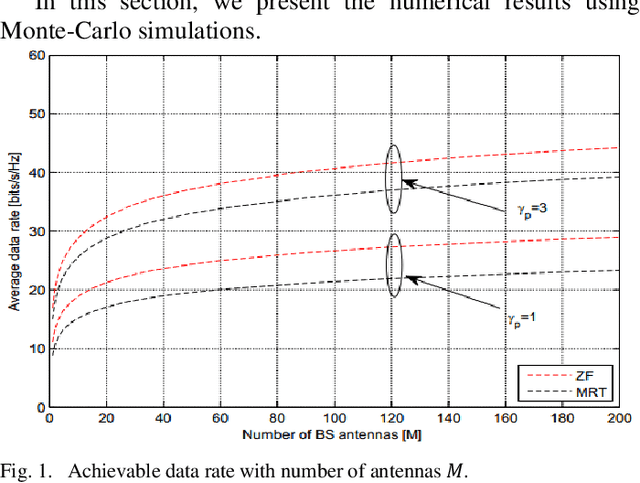
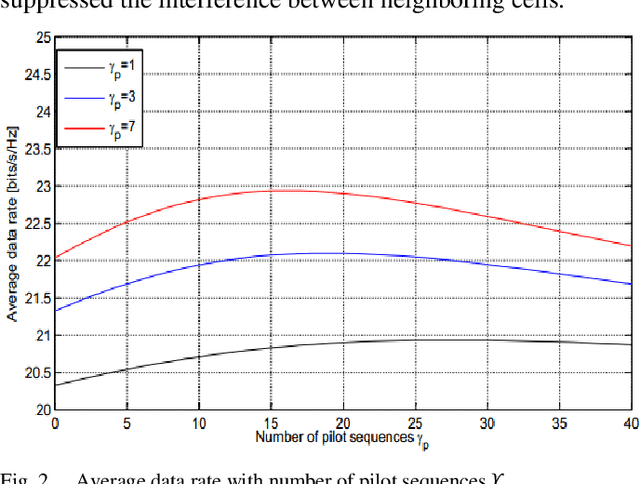
Abstract:Massive multiple-input multiple-output is a very important technology for future fifth-generation systems. However, massive massive multiple input multiple output systems are still limited because of pilot contamination, impacting the data rate due to the non-orthogonality of pilot sequences transmitted by users in the same cell to the neighboring cells. We propose a channel estimation with complete knowledge of large-scale fading by using an orthogonal pilot reuse sequence to eliminate PC in edge users with poor channel quality based on the estimation of large-scale fading and performance analysis of maximum ratio transmission and zero forcing precoding methods. We derived the lower bounds on the achievable downlink DR and signal-to-interference noise ratio based on assigning PRS to a user grouping that mitigated this problem when the number of antenna elements approaches infinity The simulation results showed that a high DR can be achieved due to better channel estimation and reduced performance loss
Trade-off Energy and Spectral Efficiency in 5G Massive MIMO System
May 22, 2021


Abstract:A massive multiple input multiple-output system is very important to optimize the trade-off energy efficiency and spectral efficiency in fifth-generation cellular networks. The challenges for the next generation depend on increasing the high data traffic in the wireless communication system for both EE and SE. In this paper, the trade off energy efficiency and spectral efficiency based on the first derivative of transmit antennas and transmit power in a downlink massive MIMO system has been investigated. The trade off EE-SE by using a multiobjective optimization problem to decrease transmit power has been analyzed. The EE and SE based on constraint maximum transmit power allocation and a number of antennas by computing the first derivative of transmit power to maximize the trade-off energy efficiency and spectral efficiency has been improved. From the simulation results, the optimum trade-off between EE and SE can be obtained based on the first derivative by selecting the optimal antennas with a low cost of transmit power. Therefore, based on an optimal optimization problem is flexible to make trade-offs between EE-SE for distinct preferences
Internet of Fly Things For Post-Disaster Recovery Based on Multi-environment
May 08, 2021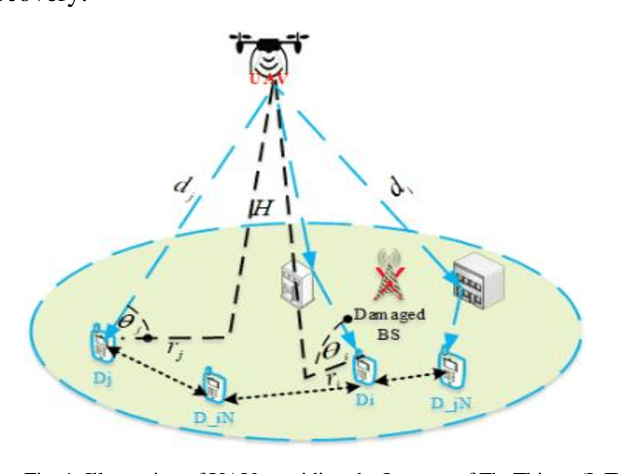
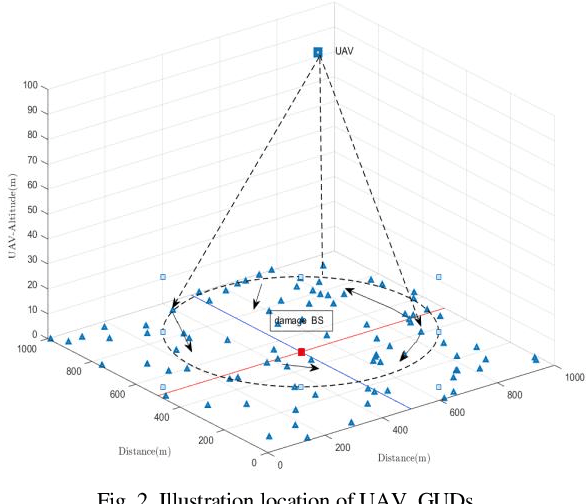
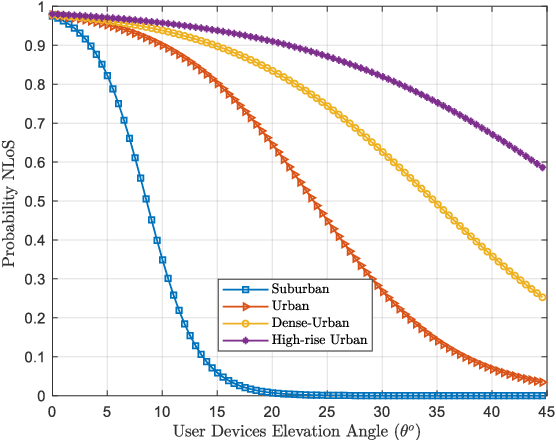
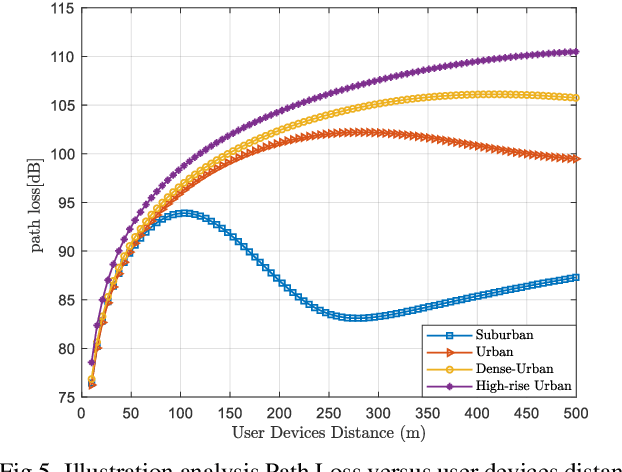
Abstract:Natural disasters such as floods and earthquakes immensely impact the telecommunication network infrastructure, leading to the malfunctioning and interruption of wireless services. Consequently, the user devices under the disaster zone are unable to access the cellular base stations. Wireless coverage on an unmanned aerial vehicle (UAV) is considered for providing coverage service to ground user devices in disaster events. This work evaluated the efficient performance of wireless coverage services of UAVs to provide the internet to fly things to help recover the communications link in a natural disaster in multi environments. The results demonstrate the line of sight, nonline of sight, path loss, and coverage probability for the radio propagation environment scenario. Therefore, the path loss and coverage probability are affected by the user devices' elevation angle and distance in the multi-environment system. The user position's optimum user device distance and elevation angle are also investigated to improve the coverage probability, which could be especially useful for the UAV deployment design.
 Add to Chrome
Add to Chrome Add to Firefox
Add to Firefox Add to Edge
Add to Edge